
"I found that 63.4 percent [of small business owners] felt that half their business came by way of referrals.
But of that same group, 79.9 percent readily admitted that they had no system of any kind to generate referrals."
John Jantsch, The Referral Engine
Modern marketing, sometimes called "content marketing" allows you demonstrate your skill as a business problem solver to potential clients.
Your potential clients have to be educated, and come to desire the benefits of your solution. Your published content provides the education they need.
Once published, you have to distribute your solutions. You need a content marketing system, which drives those readers to become potential clients - a online referral marketing system, which works 24 hours and 7 days a week.
You use your blog to post content or solutions, usually an article or white paper -although instructional videos, PowerPoint presentations, and illustrations are also used. But good content doesn't just find audiences.
(Content marketing has its origins in "Sales as a Process". "Sales as a Process", according to Tom Sant, was the unique American contribution to the 20th century and the development of the professional sales staff. Read Tom's book on The Giants of Sales: What Dale Carnegie, John Patterson, Elmer Wheeler, and Joe Girard Can Teach You About Real Sales Success for more on the history of professional sales.)
Content marketing works by allowing you to ask open ended questions of the potential customer, with the content on your blog.
Tom Sant thinks you should focus on these four main aspects, with your content.
- Where are customers losing money or opportunities?
- Why are they failing?
- How can you do to help them succeed, showing them evidence?
- Then, ask for the sale.
Now, the 20th century solution selling method worked very well when you had a customer in front of you, whom you could listen to, ask questions, and interact with.
But, online, you never know exactly who is reading your content. You cannot sell to an empty door; you have to create, measure and improve your audience first.
Measuring and Improving Your Audience.
We are going to assume that you have already created your content, and have some distribution strategy.
Now, you want to measure and improve your distribution strategy. There are three aspects of your content strategy that you need to measure: Interest, Authority, and Sales. It is not good enough to simply post your content with blog aggregator or a social media site, and wait for the clients to show up. You have to measure and improve.
Here is how Franchise Info can help you measure these aspects for your content. We will use my post on leadership: Are You an Effective Team Leader? Even on a Lousy Team? as an example.
A. Are You Interesting?
The article, which describes a neat twist on a classic negotiation training game, was published at the Franchise Info's website on Monday, August 22nd, 2011. I shared it with some Linkedin groups and it was put in the Franchise Info's newsletter on Thursday, August 25th, 2011.
Three and half years later, the basics of measuring remain the same.
The inclusion in the Franchise Info newsletter is critical because it delivered the big bump in interest. You will need something like this for you own distribution strategy or you will have little or no traffic to measure. This is the main reason authors join the Franchise Info Key Partner Program or Newsletter Program; you need to get this bump in traffic to analyze.
Here is the screenshot from Google's Analytics, August 22nd to October 2nd, 2011.
Did people find this article interesting? Did they click on the headline to read the article?
Here are 5 useful numbers or measures the Franchise Info looks at: Pageviews, Average time, Source, Variation, and Keywords to determine whether this article was interesting for our audience, newsletter or online.
1. Pageviews: This is a rough estimate of how many times the article was read, with the unique pageviews being a rough estimate of the number of people who read the article. It is more complicated than that, but if you are comparing articles with each other or against an average, then you can use this simplified idea. Just don't treat these numbers as measuring the exact number of people who read the article.
For the month, or little over, there were 458 pageviews - which is good size for an article of this type of article on a B2B website. A great article would have double the amount of pageviews.
But did this audience find it engaging, after they clicked on the headline?
2. Average Time on Page: The audience spent over 5 minutes reading this article. This is a lifetime for online articles - which are mostly skimmed. (It did take me over ten years of thinking about this training exercise to construct the article, so 5 minutes a reader seems fair.) Yes, this audience was engaged by this content.
But who was this audience? Where did they come from?
3. Source: Now, lets move to the source view in Google's Analytics.
Franchise Info's contacts at Linkedin provided 122 pages, and 4:21 minutes of their attention. Smartblogs, the American Express Open Forum, was next with 70, while Businessweek provided 43, and Forbes and the Globe and Mail provided 4 each. (The source "Direct" measures the readers from Franchise Info's newsletter audience)
(Of some interest is the 0 minute entry for the Facebook source.)
The source information reveals the size of the audience from each social community. I am pleased that the article resonated with Linkedin, American Express, and Businessweek readers. They are people likely interested in negotiation and mediation training. Some of them may have had already enrolled in the Harvard's Program on Negotiation course.
(Interestingly, although the article was given an explicit recommendation at Forbes, only few readers followed from the referral -likely because the referral was to the Franchise Info's about page and not directly to the article)
4. Variation or Backlinking Strategy: The usual pattern is for an article to receive a lot of attention when first published and then little or no attention afterwards - 0's or 1's pageviews after publication. This is not good.
But the attention pattern for the Are You an Effective Team Leader? Even on a Lousy Team? article was different.
Google's Analytics shows the article attracted attention after its publication, and more than 1/2 of its attention came after Thursday, August 2011. Roughly, 225 pageviews after publication before the newsletter audience.
Why was this? Is this article so inherently interesting? No. What this article has is a catchy synopsis:
"A CEO or leader who can coordinate ordinary effort receives extra-ordinary compensation. I have written a small exercise to test for this skill."
Whenever, I find an appropriate discussion on leadership, I use the synopsis and backlink from that community to the article. Those backlinks created the American Express and Businessweek audience. This technique is very important for your backlinking strategy, because without it the value of the article dies.
5. Keywords: We have been concentrating on the information provided by the SOURCE category in Analytics; let's switch views to the KEYWORD category.
I am going to show you something shocking, which may save you some a lot of money and grief.
Nobody who came from Google, searching for a relevant syntactic criteria, spent anytime reading the article: 0 minutes.
If I spent one dime or minute on SEO, it would have been wasted.
There is a larger theme here: for most of you who are trying to selling solutions B2B, SEO, search engine optimization, is next to worthless. Knows some basic SEO, don't spend any marketing money on it.
Your potential clients are not people who are using long tail keyword searches to find products or product reviews. Your potential clients need education about their problem, solutions in general, and the benefits of your solution.
Google's syntactic understanding of my article is minimal. How do you know? Look at what Google thinks is relevant, by looking at the Ad Links above the title.
Only 25% of these potential sponsors are relevant. This is not a good average, but it is what you expect from a machine which cannot read and understand, but can only process minimal syntactic considerations, such as placement of terms and links to those terms.
However, not all content marketing articles will produce SEO blind results.
Look at Google's understanding of Ben Baker's article on QR codes: How QR Codes can Drive Traffic to Your Website.
Or look at Samuel Salter's: 3 Tips on How to Succeed at Tradeshows.
The Google machine appears to understand what these articles are about based on syntax. Both Ben and Samuel are selling products or goods that the Google machine seems to understand. Further research would be needed to confirm this.
For most though, SEO for B2B content marketing, which focuses on solutions and not slogans, should not be a high priority. The search engines deliver people who will not read, and so will not learn.
Summarizing the interest factor, the article was widely read with the social audience coming from groups that are likely interested in negotiation and mediation topics. Creating the appropriate backlinks was critical.
Score it 8/10 for interest.
B. Are You Authoritative?
An authority should be recognized by other experts - think of the blurbs you read on best sellers. Testimonials from other experts which pre sell you on the importance of the book.
Victoria Pynchon, a recognized expert on negotiation and training, had a nice testimonial and I managed to sneak in a link to the article.
Stephen Frenkel, an expert traininer in leadership, had some great comments on the article.
But, the article fails to be socially authoritative because none of the authors who appear on Google's front page for "Win as Much as You Can", the game which the article is based upon, have commented on the article.
Here is a list, as of October 3rd, 2011, of Google's top 5 entries for the phrase.
My goal is, now, is to engage some of these authors in a more robust discussion of this exercise and related concepts.
I want to do more than simply get backlinks from these websites, even if they are Google's authorities for "Win as Much as You Can". (Interestingly, the actual designer of this game Gerald Williams is not listed on the top ten.) Backlinks are the focus of creating interest, but for authority you want real people making observations and challenging your conclusions directly.
In summary, the failure to have Google's authorities comment or engage reduces the social authority score.
Score it 5/10 for social authority.
C. Are You Asking for the Sale?
We have found measures to support the claim that the article is interesting and somewhat authoritative.
But what do I want people to do after reading the article? What did people actually do after reading the article? (What do you want people to do after reading your content marketing article?)
Let's look at what readers actually did.
There are 3 measures from Google Analytics: Bounce Rate, Exit Rate, and On-Page Analytics.
1. Bounce Rate: This is the % of people who only visit this page, and in this case it is very high compared to the site average, 91.15%
2. Exit Rate: This is the % of people who, once they reach this page, leave the site. Again, this number is high 77.07%.
Further, in the social groups that I believe are interested in negotiation training and concepts, these averages are even higher.
These measures could be good or bad. They could be good because the article was exactly what the reader wanted and went off satisfied. Or, the reader just went off ...
How do we tell?
The main marketing point of this article was to generate some interest in the joint negotiation training project between Franchise Info and MWI, Mediation Works Inc. MWI teaches the Harvard theory of interested based negotiation and mediation, and has highly trained individuals providing the training. Franchise Info is interested in promoting joint program aimed the franchise community.
There was a subtle call to action in the final paragraph of the article - a link the the MWI mini website.
How subtle? Google's in-page analytics shows the number of clicks the article generated to the MWI mini website.
You see all those clicks on the MWI link? Neither do I. There were zero clicks on "my very subtle" call to action. A decent click through would have been 2% and anything north of 5% would have been great. But zero is zero.
Score it 0/10 for marketing.
Overall Conclusion:
The information and metrics provided by Google's Analytics - which took me about 15-20 minutes to review on a monthly basis- showed support for the article being interesting, gave me a good direction for achieving more authority.
The analytics showed me that, apart from needing more engagement from the top 5 ranking authorities, I have to completely re-write the call to action or drop this as a content marketing article.
It is still valuable piece, worthwhile for me to have written. But, I am deluding myself that this article is selling any negotiating services.
If you are trying to grow your word of mouth referral network, and are interested in content marketing, become a Key Partner & Let Franchise-Info Distribute Your Ideas

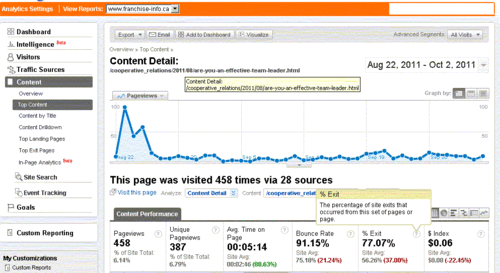
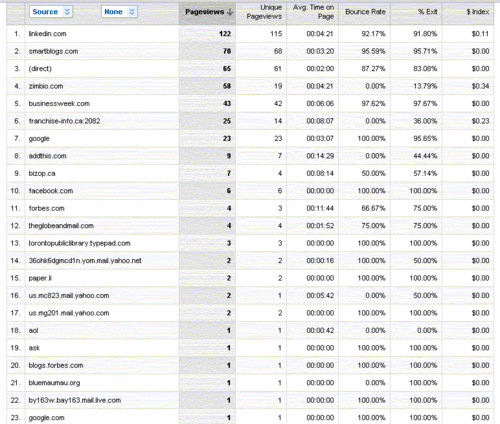
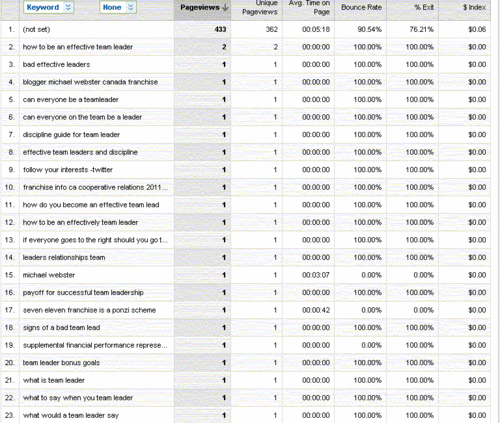



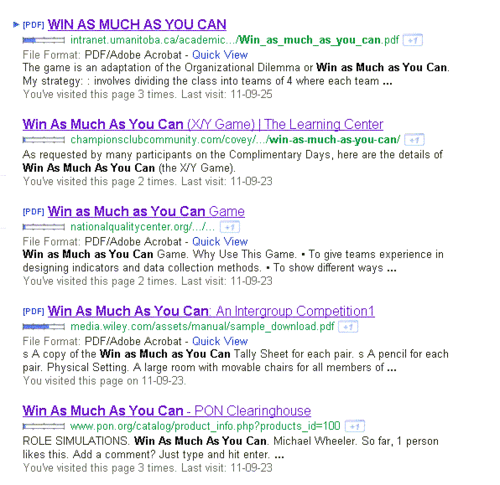

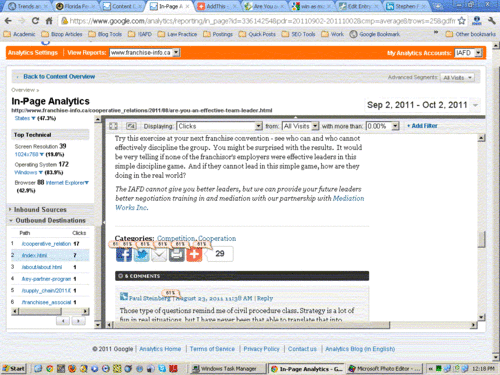

Nice work! Very thorough example - loved it.
Hi, Michael. I would add that blogs and social media are also part of a content marketing strategy.
Check out this resource:
http://www.contentmarketinginstitute.com/2010/09/b2b-content-marketing/
Content should serve to educate potential customers and help solve their problems.
There really isn't a marketing call to action, as that would be seen as a sales pitch.
Prospects are more likely to turn to you as a trusted resource once they see you as a thought leader in your field.
Hope this helps. :)
Thanks, Dawn. Appreciate your kind remarks.
Elaine, thanks for the observations and links.
I am not sure that I agree with you about authority being the sole reason for a B2B post. There is a place for making a request, which is marketing.
I do see your point, and don't think that there has to be a hard sell.
The link you provided does have some interesting observations; especially liked the category - don't have enough engaging content, said over 50% of B2B marketers!
Thanks for sharing, great article!
Thanks, Michelle. Appreciate it.
Very interesting analysis and insight into SEO and Google analytics. I am not a student or praticing SEO disciple, mostly because I do not see the value in the reward ratio of spending my time investigating it. I am thankful that you do and that you are sharing your insight.
What I found particularly facinating was your open dialog about the end results. Few articles I have read about SEO admit and share final results (again my understanding of the topic is glancing).
As a sales and marketing person I always keep my eye on the prize, and the prize is often tabulated by the number of attendees, orders, etc.
Those tabulations are merely "analytics", along the road, because the real prize is your ultimate goal.
0/10 is one analytic, the question I have for you Michael is, did this analytic help you get closer to your ultimate prize?
My guess is that it did, and that is the real value with this exercise.
Thank you for sharing.
Michael, masterful layout of such valuable information.
RE: your conversation with Elaine - there certainly is a time and place for a 'pitch', albeit subtle these days. The pitch depends on numerous factors, including audience, delivery method, the writer's goals, etc. An article posted on an article directory site can't contain a call to action, but the resource box makes up for it. A blog post might not end with a CTA, but if the writer is smart, she will add relevant links in the body to direct the reader. In-text advertising, such as that offered by my client, InTopic Media, is growing in popularity as marketers look for new ways to drive traffic.
Anyway, for the average business owner or anyone not familiar with analytics, this info is invaluable, and I intend to share it widely with my network. Thanks!
Jim, the takeaways from the article should be simple for anyone, now - if I have done my job correctly!
1. Interesting - look at page views, then average times, then and then source. Use a backlinks strategy to increase variation after publication.
2. Authority - use Google's top ten authorities to try to engage people.
3. Marketing - measure some call to action, something you want people to do after reading the article, if they want more.
I am not sure how I will position article on Leadership as a marketing piece. Elaine may be right and it will simply stand as is - no call to action. On the other hand, Victoria makes a persuasive case of some call to action. It might make sense to have a sponsor for the page with a PDF download for a free chapter of a book.
Victoria, I am more inclined to your view than Elaine's. Elaine's marketing skill is heavily aimed at non-profits and charities, which may reflect her ideas.
The in-text advertising is interesting, but I am wary of sending the reader away before they see the big point. But, it is certainly better than relying upon Google's adsense.
I am more inclined to find a sponsor of the page, somebody with complementary offerings to what the page is talking about.
(Thanks for sending it around your network - which always seems to read everything you recommend!)
Excellent article, very informative, good length, excellent use of examples. There is nothing I have to add that would improve on it.
Great example on how to review our content efforts. Content be it online or on paper should always have clear objectives and purpose-- is it to create credibility as a subject matter expert, information only or is it really marketing/sales with a call to action as you noted at the end where you were subtle. In today's online experiences even articles with no direct call to action have the various 'contact" us buttons to create some level of interaction which sometimes confuses the writer.
Presenting a problem with possible solutions/options can be presented in both ways depending on what it is you want to generate.
I struggle many times since I want to be recognized or at least acknowledged as giving value but at the end I also want to be engaged in the conversation through interactions such as posts back to the blog if possible or through a direct contact.
As with any business task, we need to take time to understand what is working and how it may be working to know how to adjust. To this, we need to have clarity of purpose and discipline our efforts.
I'm not saying there shouldn't be a call to action at all, Michael, but just not blatant.
In my monthly newsletter, one column is for pure content.
On the right-hand sidebar, I include info on products and services, along with announcements and resources.
Good point, Elaine.
Some writers are uncomfortable with asking readers to take action.
For profit or non-profit you must invite the reader to do something.